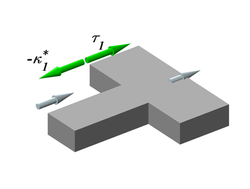SOFTWARE → LORD PICS™ (ASTERIA© PACKAGE)
OVERVIEW
Lord PICS™ (Photonic Integrated Circuits) analyzes typical building blocks elements of the Integrated Optics family such as: Directional Coupler, Ring/Racetrack resonator, Mach-Zehnder Interferometer and Fabry-Pérot resonator. Circuits are analyzed using the well known and stable, Steady-State models. It is possible to simulate chained circuits, where a circuit outputs can be connected to the next circuit inputs.
The waveguide characteristic comprising the circuit is expressed through the effective index of the propagating mode, neff.
Its spectrum and effects, such as material dispersion, temperature and doping variations, can be analyzed by Doctor Modes™ and be integrated within the circuit's simulation. The group index, ng, and group velocity dispersion, D, can be also examined.
The coupler region of the resonator, i.e. the Directional Coupler, may be either lumped or, currently, solved using data obtained by Doctor Modes™ in combination with Mode Transition theory (Supermodes interference). Consequently, the coupler's dispersion and other properties can be analyzed independently of the circuit. Both the parallel and the curved (bent) sections of the coupler can be considered and be inspected separately. It is possible to simulate effects such as temperature or applied voltage, induced by either a thermal or electrical electrode, over the coupler, thus making the coupler configurable.
Asymmetries in a coupler are supported as well (for example, one of the guides is wider than the other).
The software analyzes the transmittance of the circuit from the throughput and drop ports, Et-1 and Et-2, as well as the build-up field in a resonance device, EB. The field's amplitude, power and phase can be plotted as a function of the spectrum, resonator phase, temperature, applied voltage and In-phase Quadrature (IQ) plane. General details about the circuit, such as FSR, FWHM, Finesse, Cross-Talk, and more, are calculated as well. The circuit model equation and coupling equations are displayed for the user convenience.
Electro-Optical simulations can be performed by applying voltage on an electrical electrode related to the circuit. The electrode may be that of a PN/PIN diode or a MOS capacitor. Upon applying voltage over the electrode, the refractive index of the material changes due to the presence of charged carriers. The dependence of neff as a function of nGuide or ∆NDope can be attained by Doctor Modes™. In a similar manner, the electrode may also serve as a Thermo-Optical electrode with a temperature relation to the guided mode, neff(T).
Furthermore, the loss coefficient can be depended on the applied voltage to account for losses due to the presence of charged carriers, α(V).
The built-in Analysis Tool can be used to examine how a certain property of the circuit changes when other parameters varies. For example, one may wish to examine the Q-Factor of a microring resonator while changing its radius at 2µm steps.
The Linkage Tool can be used through the Analysis Tool to link a change in one parameter to a change of another. For example, increasing the loss coefficient of the device when increasing the input optical field, i.e., linking α to EIN-1.
Measurement files can be loaded in Lord PICS™ for comparison with theory. In addition, filter can be applied on
the measurement data in order for the software to be able to deduce the circuit properties and to provide the usage of the Analysis Tool over the filtered data.
Below, some of the circuits and couplers which can be analyzed by Lord PICS™:
 |  |  |
|---|---|---|
 |  |  |
 |  |  |
 |  |  |
 |  |  |
 |  |  |
 |  |
A glimpse to some of the circuits and couplers
-
Custom-made circuits and couplers can be added by request…
